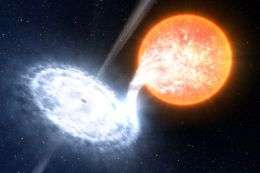Violent flickering in Black Holes

(PhysOrg.com) -- Unique observations of the flickering light from the surroundings of two black holes provide new insights into the colossal energy that flows at their hearts. By mapping out how well the variations in visible light match those in X-rays on very short timescales, astronomers have shown that magnetic fields must play a crucial role in the way black holes swallow matter.
Like the flame from a candle, light coming from the surroundings of a black hole is not constant — it flares, sputters and sparkles. "The rapid flickering of light from a black hole is most commonly observed at X-ray wavelengths," says Poshak Gandhi, who led the international team that reports these results. "This new study is one of only a handful to date that also explore the fast variations in visible light, and, most importantly how these fluctuations relate to those in X-rays."
The observations tracked the shimmering of the black holes simultaneously using two different instruments, one on the ground and one in space. The X-ray data were taken using NASA's Rossi X-ray Timing Explorer satellite. The visible light was collected with the high speed camera ULTRACAM, a visiting instrument at ESO's Very Large Telescope (VLT), recording up to 20 images a second. ULTRACAM was developed by team members Vik Dhillon and Tom Marsh. "These are among the fastest observations of a black hole ever obtained with a large optical telescope," says Dhillon.
To their surprise, astronomers discovered that the brightness fluctuations in the visible light were even more rapid than those seen in X-rays. In addition, the visible-light and X-ray variations were found not to be simultaneous, but to follow a repeated and remarkable pattern: just before an X-ray flare the visible light dims, and then surges to a bright flash for a tiny fraction of a second before rapidly decreasing again.
None of this radiation emerges directly from the black hole, but from the intense energy flows of electrically charged matter in its vicinity. The environment of a black hole is constantly being reshaped by a riotous mêlée of strong and competing forces such as gravity, magnetism and explosive pressure. As a result, light emitted by the hot flows of matter varies in brightness in a muddled and haphazard way. "But the pattern found in this new study possesses a stable structure that stands out amidst an otherwise chaotic variability, and so, it can yield vital clues about the dominant underlying physical processes in action," says team member Andy Fabian.
The visible-light emission from the neighbourhoods of black holes was widely thought to be a secondary effect, with a primary X-ray outburst illuminating the surrounding gas that subsequently shone in the visible range. But if this were so, any visible-light variations would lag behind the X-ray variability, and would be much slower to peak and fade away. "The rapid visible-light flickering now discovered immediately rules out this scenario for both systems studied," asserts Gandhi. "Instead the variations in the X-ray and visible light output must have some common origin, and one very close to the black hole itself."
Strong magnetic fields represent the best candidate for the dominant physical process. Acting as a reservoir, they can soak up the energy released close to the black hole, storing it until it can be discharged either as hot (multi-million degree) X-ray emitting plasma, or as streams of charged particles travelling at close to the speed of light. The division of energy into these two components can result in the characteristic pattern of X-ray and visible-light variability.
The two black holes studied here, GX 339-4 and SWIFT J1753.5-0127, are the remnants of massive dead stars in the Milky Way. They are embedded in separate "binary" stellar systems, where the black hole is bound to a normal star that is losing matter to its dark companion. Both black holes have masses of around ten times that of our Sun, yet the size of their orbits is only a few million kilometres, much more compact than the orbit of Mercury around our Sun.
References:
1. Gandhi, P., Makishima, K., Durant, M., Fabian, A. C., Dhillon, V. S., Marsh, T. R., Miller, J. M., Shahbaz, T. & Spruit, H. C., Rapid optical and X-ray timing observations of GX 339-4: flux correlations at the onset of a low/hard state, Monthly Notices of the Roy. Astron. Soc. Letters, 390, L29 (2008), astro-ph/0807.1529
2. Durant, M., Gandhi, P., Shahbaz, T., Fabian, A., Miller, J., Dhillon, V. S. & Marsh, T. R,. SWIFT J1753.5-0127: a surprising optical/X-ray cross-correlation function,The Astrophysical Journal, 682, L45 (2008), astro-ph/0806.2530
Provided by ESO




















